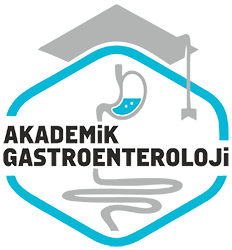Nisan 2022
Gastrointestinal kanalda inflamatuvar fibroid polip: Tek merkeze ait 10 yillik deneyimin değerlendirilmesi
Inflammatory fibroid polyp of the gastrointestinal tract: An evaluation of 10 years of experience at a single center
- Ana Sayfa
- Sayılar
- Nisan 2022
- Gastrointestinal kanalda inflamatuvar fibroid polip: Tek merkeze ait 10 yillik deneyimin değerlendirilmesi...
Özet
ÖZET • Giriş ve Amaç: Inflamatuvar fibroid polip gastrointestinal kanalda nadir gelişen benign bir lezyondur. Çalışmamızda 10 yılda hastanemizde gastrointestinal kanalda bildirilen inflamatuvar fibroid polip olgularinin klinik, morfolojik ve immünohisto kimyasal özelliklerini tartis-mayi amaçladık. Gereç ve Yöntem: Bu çalışmada 22 inflamatuvar fibroid polip olgusu klinik, morfolojik ve immünohisto kimyasal özellikleri ilesunulmuştur. Olgularin yaşi, cinsiyeti, inflamatuvar fibroid polip için uygulanan tedavi sekli, tümörün çapi, lokalizasyonu ve morfolojik özellikleriile immünohisto kimyasal boya sonuçları kaydedilmıştır. Bulgular: Olgularin 19’u (%86.4) kadın, 3’ü (%13.6) erkekti. Olgularin yaşlari 44 - 74arasında degismekte olup, ortalama yaş 60 ± 6.9 yıldi. Lezyon boyutlari 0.7 - 5.5 cm arasında degismekte olup, ortalama 1.9 cm idi. Inflamatuvarfibroid polip En sık mide (n: 13) lokalizasyonunda idi, bunu ince barsak (n: 8) ve kolon (n: 1) takip etmekteydi. Olgularin tümünde tipik morfolojiközellikler olan ince ve kalin duvarli damarlarin eslik ettigi igsi hücre proliferasyonu ve eozinofil infiltrasyonu izlendi. Vimentin tüm olgularda diffüzpozitif bulundu. 21 olguda CD34, 3 olguda düz kas aktin pozitifti. 4 olguda östrojen reseptörü fokal boyanma, 1 olguda progesteron reseptörü fokalboyanma gösterdi. Olgularin tümünde S100, desmin, CD117, androjen reseptör negatifti. Sonuç: Inflamatuvar fibroid polip submukozada lokalizeolup sıklıkla mukozaya ilerleyebilmektedir. Regüler vasküler patern, igsi hücre proliferasyonu, eozinofilik infiltrasyon tipik morfolojik bulgularidir.Gastrointestinal kanalda igsi hücreli tümörlerin ayirici tanısında inflamatuvar fibroid polip yer almalidir. Klasik mikroskopik görünümü dışında morfolojik bulgular gözlendiginde ayirici tanınin zor olabilecegi akilda tutulmali ve tanınin immünohisto kimyasal belirteçlerle desteklenmesi gerektigiunutulmamalidir
Abstract
ABSTRACT • Background and Aims: Inflammatory fibroid polyp is a rare benign lesion in the gastrointestinal tract. This study aimed to discuss the clinical, morphological, and immunohistochemical features of inflammatory fibroid polyp in the gastrointestinal tract that were reported at our hospital over 10 years. Materials and Method: This study presents 22 cases of inflammatory fibroid polyp with their clinical, morphological, and immunohistochemical features. Age, gender, inflammatory fibroid polyp treatment method, tumor diameter, localization, morphological features, and immunohistochemical staining results were recorded. Results: Of the cases, 19 (86.4%) were women and 3 (13.6%) were men, with ages 44–74 years (mean age, 60 ± 6.9 years). The lesion sizes were 0.7–5.5 cm (mean size, 1.9 cm). Inflammatory fibroid polyp was most common in the stomach (n: 13), followed by the small intestine (n: 8) and colon (n: 1). Spindle cell proliferation and eosinophil infiltration accompanied by thin- and thick-walled vessels were observed in all cases. Vimentin was diffusely positive in all cases. CD34 was positive in 21 cases, and smooth muscle actin was positive in 3 cases. Estrogen receptor focal staining was performed in four cases and progesterone receptor focal staining in one case. S100, desmin, CD117, and androgen receptor were negative in all cases. Conclusions: Inflammatory fibroid polyp is localized in the submucosa, which often extends into the mucosa. Regular vascular pattern, spindle cell proliferation, and eosinophilic infiltration are typical morphological findings. Inflammatory fibroid polyp should be included in the differential diagnosis of spindle cell tumors in the gastrointestinal tract. With morphological findings other than its classical microscopic appearance, differential diagnoses should be acknowledged as difficult and diagnosis should be supported by immunohistochemical markers.



